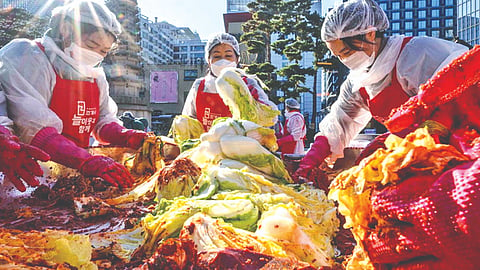Food matters: South Korea struggles to serve up national dish ‘kimchi’
Julian Ryall
South Korea has been forced to sharply increase imports of “kimchi” — arguably the most important dish on every family’s mealtime table — giving rise to concerns about the quality of foreign versions of the fiery fermented staple. Government statistics show that South Korea imported kimchi with a value of $169.4 million in 2022, up 20.4% over the previous year, Yonhap News reported. That increase was the sharpest since a rise of nearly 54% in 2010.
A powerful combination of fermented cabbage, salt and hot peppers, kimchi is an indispensable part of the Korean diet. The nation consumes more than 2 million tons of it every year. Most often served as a side dish, it can also be incorporated into soups and stews, with studies indicating that more than 90% of South Koreans eat kimchi every day. And while it remains a critical part of the national cuisine, changes in society have inevitably impacted the dish. Traditionally, women would gather to prepare the ingredients and start the natural fermentation process, ensuring that there would be enough to feed the family through the bitterly cold winter months.
Today, that tradition has faded and most people purchase preprepared kimchi during their regular visits to the supermarket.
Consumers have largely been able to rely on domestic sources for their kimchi needs, although that has been changing. A couple of bad growing seasons have impacted cabbage crops, increasing prices and reducing availability, but the broader rise in prices — everything from vehicle fuel to electricity and the cost of ingredients — has made it harder for producers to remain competitive.
Squeezed by rising costs and falling consumer numbers, restaurants have been quick to switch to imported kimchi.
“The price of absolutely everything has been rising for the last year and it’s the same for domestic kimchi manufacturers,” said Lim Eun-jung, an associate professor of international studies at Kongju National University — and someone who can remember making kimchi with her grandmother as a young child.
“On top of that, we have had a couple of bad summers that have badly affected the cabbage harvest,” she told DW. “There are also the other ingredients that have become more expensive and it’s a labour-intensive process, so it is not really a surprise that it is cheaper to produce kimchi abroad and then import it.”
Lim said she usually purchases her kimchi from farmers’ markets or online stores so she can verify where it comes from, and she does not mind paying a little more if that gives her peace of mind about the quality. “I think a lot of people have a low level of trust for kimchi and other food that is imported, particularly factory-made food from places like China,” she said. “People worry about sanitation levels and the quality of the ingredients they use, although there is no question that it is much cheaper.”
Koreans also became angry when Chinese state media claimed the dish originally originated in China, triggering a sharp exchange of opinions in the two nations’ media and online chat rooms.
Visit news.dtnext.in to explore our interactive epaper!
Download the DT Next app for more exciting features!
Click here for iOS
Click here for Android

